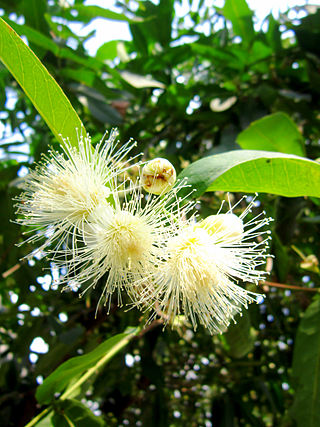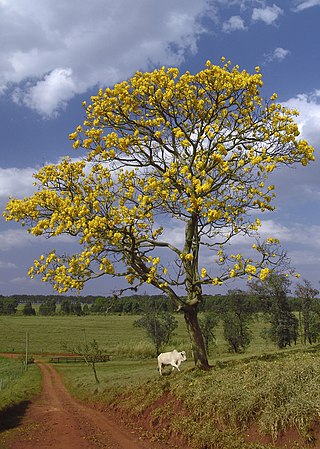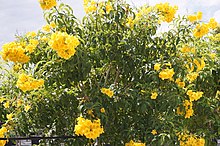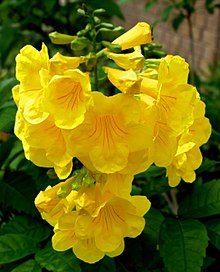
Magnolia virginiana, most commonly known as sweetbay magnolia, or merely sweetbay, is a member of the magnolia family, Magnoliaceae. It was the first magnolia to be scientifically described under modern rules of botanical nomenclature, and is the type species of the genus Magnolia; as Magnolia is also the type genus of all flowering plants (magnoliophytes), this species in a sense typifies all flowering plants.

Syzygium samarangense is a species of flowering plant in the family Myrtaceae, native to an area that includes the Greater Sunda Islands, Malay Peninsula, and the Andaman and Nicobar Islands, but introduced in prehistoric times to a wider area and now widely cultivated in the tropics. Common names in English include wax apple, Java apple, Semarang rose-apple, and wax jambu.

Spathodea is a genus in the plant family Bignoniaceae. The single species it contains, Spathodea campanulata, is commonly known as the African tulip tree. The tree grows between 7–25 m (23–82 ft) tall and is native to tropical dry forests of Africa. It has been nominated as among 100 of the "World's Worst" invaders.

Caesalpinia pulcherrima is a species of flowering plant in the pea family Fabaceae, native to the tropics and subtropics of the Americas. It could be native to the West Indies, but its exact origin is unknown due to widespread cultivation. Common names for this species include poinciana, peacock flower, red bird of paradise, Mexican bird of paradise, dwarf poinciana, pride of Barbados, flos pavonis, and flamboyant-de-jardin. The Hawaiian name for this plant is ʻohai aliʻi.

Pandorea is a genus of nine species of flowering plants in the family Bignoniaceae and is native to Australia, Malesia, New Guinea and New Caledonia. Plants in the genus Pandorea are mostly woody climbers with imparipinnate leaves arranged in opposite pairs, flowers in groups with tube-shaped flowers, and winged seeds.

Cephalanthus occidentalis is a species of flowering plant in the family Rubiaceae that is native to eastern and southern North America. Common names include buttonbush, common buttonbush, button-willow, buck brush, and honey-bells.

Tecomaria capensis, the Cape honeysuckle, is a species of flowering plant in the family Bignoniaceae, native to southern Africa. Despite its common name, it is not closely related to the true honeysuckle.
Yellow bells is a common name for several plants and can refer to:

The Esmeraldas woodstar is a rare, neotropical species of hummingbird in the family Trochilidae. There are six different species in the woodstar genus. Most of them are poorly studied due to their small size, extremely similar resemblance to each other, and rarity. Esmeraldas woodstars are one of the smallest bird species. They are sexually dimorphic. The main difference between sexes is that males have a bright purple throat. Esmeraldas woodstars are found only on the Pacific coast of west Ecuador in semi-deciduous to evergreen forests. They feed on the nectar of flowering shrubs and trees. The main threat to this species is deforestation. Esmeraldas woodstars are Vulnerable and require habitat protection.

The rufous-crested coquette is a species of hummingbird native to the tropical slopes of pacific South America. Due to its small size and population, it is a rare sight even within its native region. Males of the species can be easily distinguished by their striking rufous coloured spiked crests, and females, while less obvious, can be identified by their small size and rufous coloured foreheads.

Arbutus xalapensis, commonly known as the Texas madrone, Amazaquitl, or Texas madroño, is a species of flowering plant in the heather family. It is native to Central America, the southwestern United States, and throughout Mexico. It is found in canyons and mountains, on rocky plains, and in oak woodlands, at altitudes of up to 3,000 m in the south of the range, but lower, down to 600 m in the north of the range.

Phyllanthus anamalayanus is a species of plant in the family Phyllanthaceae. It is endemic to the Anamalai Hills in Coimbatore district in the state of Tamil Nadu, India. The species is a shrub or small tree occurring in the understorey of mid-elevation tropical wet evergreen forests in the Anamalai Hills, and is endemic to the Western Ghats. It is threatened by habitat loss.

Handroanthus chrysotrichus, synonym Tabebuia chrysotricha, commonly known as the golden trumpet tree, is a semi-evergreen/semi-deciduous tree from Brazil. It is very similar to and often confused with Tabebuia ochracea. In Portuguese it is called ipê amarelo and its flower is considered the national flower of Brazil.

Myristica fragrans is an evergreen tree indigenous to the Maluku Islands of Indonesia. It is important as the main source of the spices nutmeg and mace. It is widely grown across the tropics including Guangdong and Yunnan in China, Taiwan, Indonesia, Malaysia, Grenada in the Caribbean, Kerala in India, Sri Lanka and South America.

Chiococca alba is a species of flowering plant in the coffee family (Rubiaceae) native to Florida and the extreme southern tip of Texas in the United States, Bermuda, Mexico, Central America, the Caribbean, the Galápagos, and tropical South America. Common names include David's milkberry, West Indian milkberry, cahinca and West Indian snowberry. The specific epithet, alba, means "white" in Latin and refers to the color of its fruits.
Hypodaphnis is a monotypic genus of flowering plants of the family Lauraceae. Its only extant species, Hypodaphnis zenkeri, is native to Gabon. Although only one living species is known, fossils of some species of this genus are present in North America, especially in Northern Mexico. In most phylogenetic analysis, Hypodaphnis appears as the basal branch, the sister group of the rest of the family Lauraceae.

Astianthus is a monotypic genus of flowering plants in the Bignoniaceae family. The sole species is Astianthus viminalis. It is known by the common names achuchil in Mexico and chilca in Guatemala and Honduras.

Portlandia coccinea is a small tree or shrub with bright red flowers endemic to Jamaica. The species was first described in 1788. A population with darker flowers had been considered a subspecies of P. coccinea, but was described as a separate species, P. proctori, in 2003.

Corokia cotoneaster is a flowering plant in the family Argophyllaceae was described by Étienne Fiacre Louis Raoul in 1846. This plant is commonly known as the wire-netting bush, korokio, or korokia-tarango. The word "Koriko" comes from the Māori language.

Podranea ricasoliana, called the pink trumpet vine, is a species of flowering plant in the genus Podranea, native to South Africa, Malawi, Mozambique and Zambia. It has gained the Royal Horticultural Society's Award of Garden Merit.































